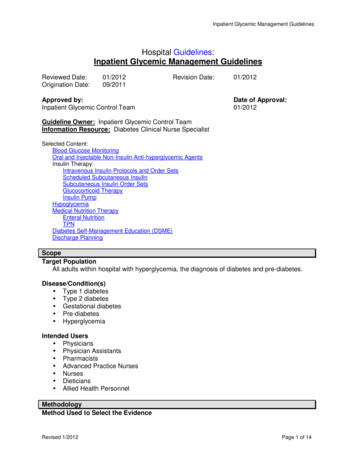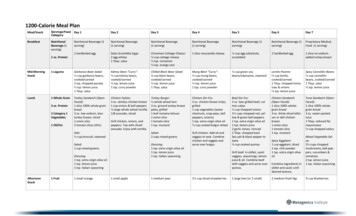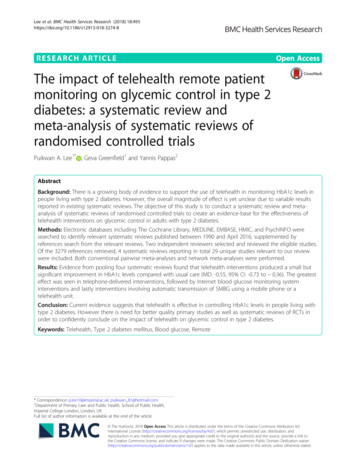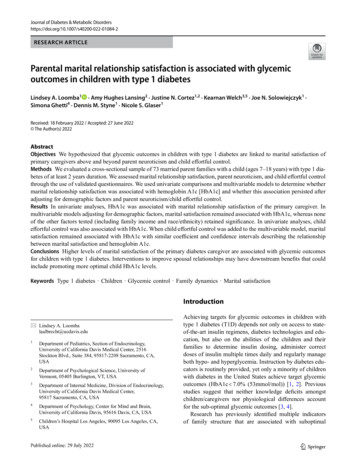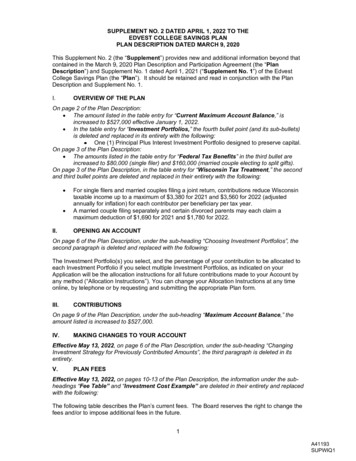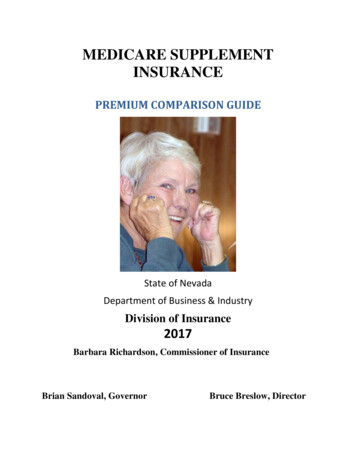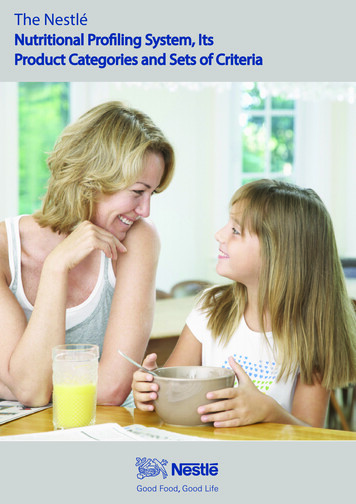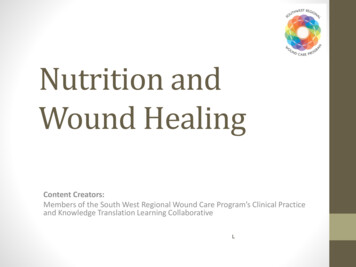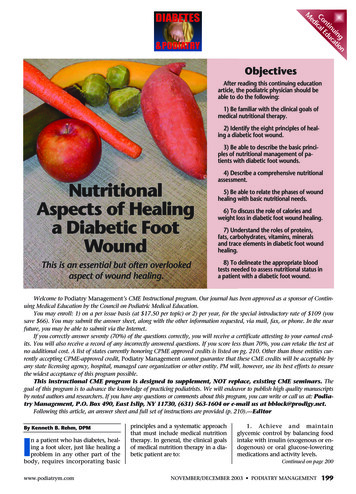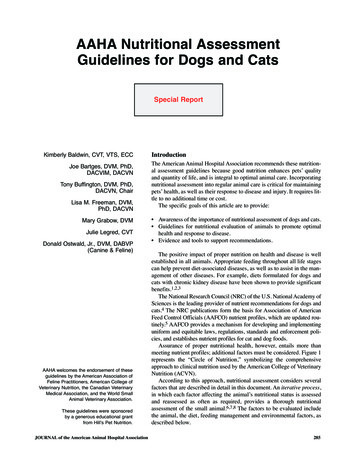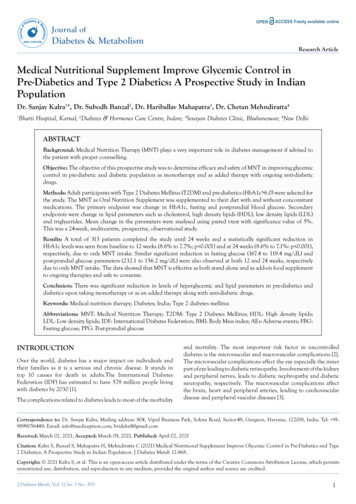
Transcription
nJou r al ofbolismetaMbetes &DiaISSN: 2155-6156OPENJournal ofACCESS Freely available onlineDiabetes & MetabolismResearch ArticleMedical Nutritional Supplement Improve Glycemic Control inPre-Diabetics and Type 2 Diabetics: A Prospective Study in IndianPopulationDr. Sanjay Kalra1*, Dr. Subodh Banzal2, Dr. Hariballav Mahapatra3, Dr. Chetan Mehndiratta4Bharti Hospital, Karnal; 2Diabetes & Hormones Care Centre, Indore; 3Sevayan Diabetes Clinic, Bhubaneswar; 4New Delhi1ABSTRACTBackground: Medical Nutrition Therapy (MNT) plays a very important role in diabetes management if advised tothe patient with proper counselling.Objective: The objective of this prospective study was to determine efficacy and safety of MNT in improving glycemiccontrol in pre-diabetic and diabetic population as monotherapy and as added therapy with ongoing anti-diabeticdrugs.Methods: Adult participants with Type 2 Diabetes Mellitus (T2DM) and pre-diabetics (HbA1c 6.0) were selected forthe study. The MNT as Oral Nutrition Supplement was supplemented to their diet with and without concomitantmedications. The primary endpoint was change in HbA1c, fasting and postprandial blood glucose. Secondaryendpoints were change in lipid parameters such as cholesterol, high density lipids (HDL), low density lipids (LDL)and triglycerides. Mean change in the parameters were analysed using paired t-test with significance value of 5%.This was a 24-week, multi-centre, prospective, observational study.Results: A total of 313 patients completed the study until 24 weeks and a statistically significant reduction inHbA1c levels was seen from baseline to 12 weeks (8.6% to 7.7%; p 0.001) and at 24 weeks (8.6% to 7.1%: p 0.001),respectively, due to only MNT intake. Similar significant reduction in fasting glucose (167.4 to 119.4 mg/dL) andpost-prandial glucose parameters (232.1 to 156.2 mg/dL) were also observed at both 12 and 24 weeks, respectivelydue to only MNT intake. The data showed that MNT is effective as both stand alone and as add-on food supplementto ongoing therapies and safe to consume.Conclusion: There was significant reduction in levels of hyperglycemic and lipid parameters in pre-diabetics anddiabetics upon taking monotherapy or as an added therapy along with anti-diabetic drugs.Keywords: Medical nutrition therapy; Diabetes; India; Type 2 diabetes mellitusAbbreviations: MNT: Medical Nutrition Therapy; T2DM: Type 2 Diabetes Mellitus; HDL: High density lipids;LDL: Low density lipids; IDF: International Diabetes Federation; BMI: Body Mass index; AEs: Adverse events; FBG:Fasting glucose; PPG: Post-prandial glucoseINTRODUCTIONOver the world, diabetes has a major impact on individuals andtheir families as it is a serious and chronic disease. It stands intop 10 causes for death in adults.The International DiabetesFederation (IDF) has estimated to have 578 million people livingwith diabetes by 2030 [1].The complications related to diabetes leads to most of the morbidityand mortality. The most important risk factor in uncontrolleddiabetes is the microvascular and macrovascular complications [2].The microvascular complications affect the eye especially the innerpart of eye leading to diabetic retinopathy. Involvement of the kidneyand peripheral nerves, leads to diabetic nephropathy and diabeticneuropathy, respectively. The macrovascular complications affectthe brain, heart and peripheral arteries, leading to cardiovasculardisease and peripheral vascular diseases [3].Correspondence to: Dr. Sanjay Kalra, Mailing address: 804, Vipul Business Park, Sohna Road, Sector-48, Gurgaon, Haryana, 122018, India, Tel: 919899056449; Email: info@mediception.com; brideknl@gmail.comReceived: March 02, 2021, Accepted: March 09, 2021, Published: April 02, 2021Citation: Kalra S, Banzal S, Mahapatra H, Mehndiratta C (2021) Medical Nutritional Supplement Improve Glycemic Control in Pre-Diabetics and Type2 Diabetics: A Prospective Study in Indian Population. J Diabetes Metab 12:868.Copyright: 2021 Kalra S, et al. This is an open-access article distributed under the terms of the Creative Commons Attribution License, which permitsunrestricted use, distribution, and reproduction in any medium, provided the original author and source are credited.J Diabetes Metab, Vol. 12 Iss. 3 No: 87 01
Kalra S, et al.OPENThe major drivers for rapidly changing dynamics of T2DM includeunhealthy modern diet and low activity patterns. Another reasonfor rising trend in diabetes include replacement of traditionalIndian meals such as legumes, coarse cereals, whole grains, fruitsand vegetables with foods having refined carbohydrates, addedsugars and high intake of fats [4].Additionally, expansion of fast food chains and supermarketshas made it very easy to access westernized foods [4]. Studiessuggest that due to improper education and guidance, diabeticscompletely remove dietary carbohydrates and include bitter foodswhich potentially lower blood glucose levels [5,6]. Due to thesemisbeliefs, the dietary guidance is ignored and it stands as a barrierto pharmacologic treatment attempts as well.For the prevention and management of diabetes mellitus, anappropriate lifestyle and dietary changes are required. An essentialcomponent of diabetes management includes Medical nutritiontherapy (MNT) along with counselling the patient. MNT comprisesof nutritional assessment, advice and follow-up, for preventionand/or management of disease, by a qualified or trained healthcare provider. It includes dietary, nutritional and culinaryadvice. It comprises of both home-made food and medical-gradeformulations.In the context of T2DM, MNT aims to manage bothdysglycemia and adiposity, through nutritional intervention [7].Evidences suggest that diabetic patients receiving MNT show declinein blood glucose parameters such as HbA1c. Such interventionsprovide improvement in overall health outcomes, reductions incost of therapy and increase in quality of life [8-13]. Thus, our aimwas to analyse safety and efficacy of MNT in glycemic managementof diabetics and pre-diabetics.METHODSA prospective observational study was carried out where total of325 adult participants were included, of which, 191 were malesand 134 were females. Inclusion criteria include participants withHbA1c levels 6.0, having no other co-morbidities or medications,except anti-diabetic drugs. Participants undergoing any other trialsor surgery were excluded from the study.The study was performed in compliance with the principles ofthe Declaration of Helsinki, in accordance with the InternationalConference of Harmonization Guideline for Good ClinicalACCESS Freely available onlinePractice, and in accordance with applicable regulatory requirements.All participants provided a written informed consent.EndpointsBody Mass index (BMI) for each participants was calculated. Theprimary endpoint was mean change in HbA1c levels, FBG andPPG from baseline to week 12 & 24 where MNT (VidavanceTM)was supplemented as monotherapy or add-on therapy with ongoingoral antidiabetic agents. Secondary endpoints were change in lipidprofile parameters (cholesterol, LDL, HDL and triglycerides) frombaseline to week 12 & 24. Adverse events (AEs) were monitoredduring the study period.Statistical analysisDescriptive statistics for continuous variable and frequency withpercentage for categorical variables were performed. Data wereanalysed and the mean data along with the standard deviation(SD) were subjected to statistical analysis using paired t-test withsignificance value of 5%.RESULTSTotal 325 participants enrolled in the study out of which 313participants (96.3%) completed the study until the end of 24weeks. Figure 1 presents the patient disposition. Compliance ratewas high among participants, with minimal drop out.DemographicsThe mean age and BMI of the study participants were 53.5 11.1 years and 28.65 1.45 kg/m2, respectively. The participantswere divided into two groups. Group I (n 157) comprised ofpatients taking MNT alone and Group II was taking concomitantanti-diabetic therapies like Metformin, Voglibose, Glimepiride,Sitagliptin, sulphonyl urea along with MNT(n 156) where ‘n’stands for number of patients.Out of 157 participants from Group I, 141 were diabetic and 16were pre-diabetic and out of 156 participants from Group II, 149were diabetic and 7 were pre-diabetic (Figure 1).Study participants were either taking concomitantly (Conmed)anti-diabetic therapies with MNT (n 156), or MNT alone (n 157).Glucose metabolism parameters & lipid profile was assessedTotal number ofPatients participatedin the end 313Group 1 157(On MNT only Monotherapy)Diabetic 141Pre-diabetic 16Group 2 156(On Conmed andMNT - Add-ontherapy)Diabetic 149Pre-Diabetic 7Figure 1: Participants Disposition Chart.J Diabetes Metab, Vol. 12 Iss. 3No: 87 02
Kalra S, et al.OPENACCESS Freely available onlinevalues were seen in both the groups as shown in Table 1. Similarsignificant changes (p 0.001) were seen in these three parametersfor pre-diabetics group as well (Table 2). All the above parametersare graphically presented in Figure 2.at baseline, 12 and 24 weeks. Subcategorized into pre-diabetic(HbA1c 6-6.5) and Diabetic (HbA1c 6.5).EfficacyThe mean values of glycemic parameters (HbA1c, FBG, and PPG)for Group I (Monotherapy) and Group II (concomitant therapy)are shown in Table 1. Mean HbA1c was 8.81% (SD 0.37) atbaseline which reduced to 7.80% (SD 0.96) at week 12 and 7.16%(SD 0.84) at week 24 with noted in Group I. In Group II, it was8.39 (SD 1.17) at baseline, 7.69 (SD 0.80) at week 12 and 7.13(SD 0.79) at week 24. The differences in the mean HbA1c inboth the groups were found to be statistically significant (p 0.001)(Table 1).Statistically significant reduction in HbA1c levels is seen frombaseline to 12 weeks (8.81 to 7.8; p 0.001) and at 24 weeks (to7.16: p 0.001) in both groups I and II in diabetics.Statistically significant reductions in mean FBG values and PPGThe effect of MNT consumption also noted on lipid parametersSimilar significant changes (p 0.001) was seen in the threeparameters in both groups for pre-diabetics as well.The values obtained were comparable with statistically significantreduction in HbA1c levels, fasting glucose and post-prandialglucose from baseline to 12 weeks and at 24 weeks.Table1: Table showing mean HbA1c, FBG and PPG values in Group I and Group II in diabetics (HbA1C 6.5).Glucose MetabolismParametersHbA1c (%)FBG (mg/dL)PPG (mg/dL)Baseline12 Weeks24 WeeksGroup I8.81 0.377.80 0.967.16 0.84Group II8.39 1.177.69 0.807.13 0.79Group I171.56 44.39141.94 39.41120.72 31.19Group II158.37 42.86138.67 0.80121.77 26.02Group I243.07 67.82190.92 50.8159.08 38.37Group II228.47 57.09185.28 44162.35 39.72Table 2: Table showing mean HbA1c, FBG and PPG values in Group I and Group II in Pre-diabetics (HbA1C 6-6.5).Glucose MetabolismParametersHbA1c (%)FBG (mg/dL)PPG (mg/dL)6.26.15 0.166.09 0.265.94 0.236.2 0.125.85 0.545.7 0.55Group I115.75 14.19102.08 8.86110.75 25.5Group II117.14 18.72105.28 20.9998.42 24.79Group I147.83 25.7135.16 13.48128.25 17.78Group II144.71 18.41131.14 26.14120 1105.855.924 WeeksGroup I6.1612 WeeksGroup IIHbA1c6.2Baseline5.714098.424090205.48512 weeks24 weeks0Baseline12 weeks24 weeksPre-diabetic108.398.8187.69 7.87.137.166171.56158.37150138.67 141.94121.77 120.72Baseline12 weeks24 weeksDiabetic012 weeks24 weeks243.07228.47185.28190.92162.35 Baseline12080955.6131.14 aseline12 weeksWith Conmed24 weeksBaseline12 weeks24 weeksMNT onlyFigure 2: Graphical comparison showing mean HbA1c, FBG and PPG values in Group I and Group II in diabetics (Prediabetic and Diabetic).J Diabetes Metab, Vol. 12 Iss. 3 No: 87 03
Kalra S, et al.OPENACCESS Freely available onlineTable 3: Table showing mean Cholesterol, LDL, HDL and Triglycerides values in Group I and Group II in diabetics (HbA1C 6.5).Lipid eline12 Weeks24 WeeksGroup I195.02 43.46182.9 28.22154.13 30Group II195.6 34.59177.3 32.57158.59 23.52Group I133.94 34.06123.41 24.2113.92 37.54Group II125.53 24.9114.44 24.26104.35 27.35Group I76.71 133.4349.94 32.2347.13 22.89Group II36.75 11.5636.74 9.1937.14 7.24Group I185.26 64.47170.26 43.45129.06 30.07Group II185.61 63.23157.55 36.47139.64 31.98Table 4: Table showing mean Cholesterol, LDL, HDL and Triglycerides values in Group I and Group II in pre-diabetics (HbA1C 6-6.5).Lipid eline24 WeeksGroup I197.83 61.78185 15.5144.8 50.8Group II200.67 31.77166.66 32.53137.66 11.67Group I116.35 44.49131 52.89102 38.45Group II148.5 55.48142 36.3685 45.82Group I39.5 9.8432.5 0.736.25 9.17Group II29.33 8.3235 8.8836.33 10.01Group I127.4 24.18127 7.07111.4 36.95Group II125 120.2175100which included levels of cholesterol, HDL, LDL and triglycerides.Mean cholesterol levels was 195.02% (SD 43.46) at baseline whichdecreased to 182.9% (SD 28.22) at week 12 and 154.13% (SD 30)at week 24 as noted in Group I and in Group II, it was 195.6(SD 34.59) at baseline, 177.3 (SD 32.57) at week 12 and 158.59(SD 23.52) at week 24. The differences in the mean cholesterol inboth the groups were found to be statistically significant (p 0.001)(Table 3).Similar significant change (p 0.001) was seen in these parametersfor pre-diabetics as well (Table 4).Numerical reduction in levels of lipid profile parameters is alsoseen in both the diabetic groups.Similar statistical significant reduction in glycemic parameters werealso observed in the concomitant groups.The data showed that MNT (ONS) is effective as both monotherapyand as concomitant or add-on therapy to reduce the glycemicparameters from baseline to end of the study (24 weeks) was seen.SafetyNo adverse events were observed till 24 weeks of follow-up in any ofthe participants, showing it was safe for consumption.DISCUSSIONMNT includes description of procedures for providing nutritionalrecommendations to an individual by a healthcare professionalwhich considers the patient’s personal, cultural and lifestylepreferences so that required target can be achieved towardsthe treatment goals. Essential components of MNT includeassessment, nutrition diagnosis, education and counselling, andmonitoring with ongoing follow-up which is required to supportlong-term lifestyle changes, evaluate outcomes and modification ofJ Diabetes Metab, Vol. 12 Iss. 3 No: 87 012 Weeksinterventions as and when required.The optimal treatment to obtain fair glycemic control is the goalof antidiabetic therapies. However, along with the antidiabeticdrugs, modifications in lifestyle and dietary precautions arealso important, where MNT plays an important role. In thisobservational study, there were significant reductions in HbA1c,FBG and PPG at the end of the 24 weeks of study. A 1.0% &1.64% reduction in HbA1c due to consumption of MNT at 12 and24 weeks, respectively in diabetics. Similar reduction was also seenin group of participants undergoing concomitant medications. Astudy conducted by Nisak et al stated that there was reduction inHbA1c levels by 0.4% (7.6 1.2 to 7.2 1.1%, p 0.001) at 12weeks after use of MNT in diabetic patients. They also noted thatbaseline HbA1c levels before the intervention affected the extentof change MNT could have on glycemic control in T2DM [14].Johnson and Valera reported six-month retrospective chart audit ofT2DM patients whose blood glucose levels decreased 33.5% afterreceiving nutrition therapy. Also, the mean total weight reductionin patients was about 2.05 kg [15].Johnson and Thomas reported decrease in levels of HbA1c by 20%in the patients who received MNT intervention over a period of12 months [16]. Christensen et al. carried out a retrospective chartreview where they found significant difference (mean pre-educationHbA1c 9.35% 2.12 to mean post-education HbA1c 7.70% 1.53, P 0.000) in contribution of medical nutrition therapy anddiabetes self-management education to diabetes control in the timespan of 3 months [13]. This study results were in accordance withother studies and thus, support the evidence that MNT plays avery important role in diabetes management. Overall MNT intakewas found to be efficacious in reducing blood hyperglycemicparameters along with lipid profile parameters.Among all glycemic parameters, PPG plays an important role inlowering the levels of HbA1c. Hence, decrease in PPG will lead4
Kalra S, et al.to greater reductions in HbA1c along with decrease in FBG. So,it is very important to control the levels of PPG [17]. Variousstudies have reported strong association of PPG with diabetescomplications and other changes such as cardiovascular andcerebrovascular complications, oxidative stress, carotid intimalthickness and endothelial dysfunction [18,19]. This study showeda significant reduction in PPG and FBG levels, providing a betteroverall glycemic control.The macro and micro vascular complications are the side-effectsof un-controlled glycemic levels. Diabetes induced dyslipidemiaincludes hypercholesterolemia; hypertriglyceridemia and elevatedLDL cholesterol are few microvascular complications started to risewhen diabetes gets uncontrolled. High prevalence of dysplipidemiaplays a major role in developing cardiovascular and cerebrovasculardiseases in diabetics. Hence, it’s crucial to monitor and maintainthe lipid parameters during anti-diabetic therapies. Our datashowed that consumption of MNT not only significantly reducesthe glycemic parameters, but also reduced the increased lipid profileparameters like LDL, Cholesterol and Triglycerides at the end of24 weeks of study. This extends the use of MNT in controlling thediabetes associated cardiac complications as well.The goal of MNT is to also promote and support healthy eatingpatterns. It emphasizes on variety of numerous nutrient-densefoods in the portion sizes which are appropriate to improve overallhealth. The aim differs from individual to individual which is basedon age, duration of diabetes, health history and current healthconditions. The focus is to improve HbA1c levels, blood pressure,and cholesterol levels. Other associated goals include maintenanceof body weight, prevention of diabetes complications, looking intoindividual nutrition needs, behavioural changes and providingdiabetics with practical tools so that day-to-day meal planning canbe done [17].MNT if given in pre-diabetics helps to reduce the transformationof pre-diabetes to diabetes. For pre-diabetics, it is a cost-effectivemeasure as it helps in improving outcomes as well as it also improvesquality of life of pre-diabetics. Out data showed that consumptionof MNT in pre-diabetics reduced HbA1c, FBG, and PPG levels at24 weeks of the use. The use of dietary strategies for prevention ofdiabetes has been successfully implemented by various studies suchas the Finnish.It should be made sure that the MNS intervention therapy is takenfrom a registered dietitian or nutrition expert. Doctors shouldencourage their patients to take health plan to achieve treatmentbenefits early. The MNS intervention therapy is helpful for prediabetic patients as timely MNS intervention therapy can preventthem from getting diabetic [18]. Diabetes Prevention Study, theDiabetes Prevention Program (DPP) and the Nurses’ Health Study.According to DPP study, the incidence of T2DM can be reducedto 58% by modification in life-style structure. Various studiesstate that with MNT have shown to decrease rate of incidenceof diabetes. The benefit of sticking to a balanced diet along withregular physical activity is improved sensitivity to insulin andpreservation of beta cells [3].This study provides a new insight on how MNT can managethe glycemic parameters and improve overall health conditions.We observed that MNT is effective to manage diabetes not onlyas monotherapy but as add-on therapy as well and were safe toconsume.J Diabetes Metab, Vol. 12 Iss. 3 No: 87 0OPENACCESS Freely available onlineLIMITATIONS OF THE STUDYIn the present study, the time duration of 24 weeks of treatmentcould be increased further for better and long-term monitoring ofthe MNT effect.CONCLUSIONOverall, it can be concluded that MNT provides an importanttreatment option to pre-diabetic and diabetic patients. MNTshould be considered as monotherapy or add-on therapy, inaddition to recommendations to increase physical activity andchange in life-style for better management of T2DM. VidavanceTMwas found to be efficacious in reducing hyperglycemic parameters:HbA1c reduced by 0.9% at 12 weeks and by 1.5% at 24 weeks, dueto only MNT. Significant reduction in fasting and post-prandialglucose was also seen.ACKNOWLEDGMENTThis work was carried out in collaboration between all authors.Authors KS and BS designed the study. All authors conductedresearch and analyzed data. Authors MH and MC managed theliterature searches and wrote the first draft of the manuscript.All authors read and approved the final manuscript. All namedauthors meet the International Committee of Medical JournalEditors (ICMJE) criteria for authorship for this manuscript, takeresponsibility for the integrity of the work, and have given finalapproval for the version to be published. Authors thank Mr.Tanmay Agrawal and Dr. Atul Mishra for executing the study.Medical writing and editorial support in the preparation of thisarticle was provided by Dr. Punit Srivastava of Mediception SciencePvt Ltd.CONFLICTS OF INTERESTNo conflict of interest.FUNDING DISCLOSUREFunding Funding was done by Signutra , New Delhi.REFERENCES1. Saeedi P, Petersohn I, Salpea P, Malanda B, Karuranga S, UnwinN et al. Global and regional diabetes prevalence estimates for 2019and projections for 2030 and 2045: Results from the InternationalFederation Diabetes Atlas, 9th Edition. Diabetes Res Clin Pract.2019;157:107843.2. Chawla A, Chawla R, Jaggi S. Microvascular and macrovascularcomplications in diabetes mellitus: Distinct or continuum? Indian JEndocrinol Metab. 2016;20(4):546-51.3. Pradeepa R, Mohan V. Prevalence of type 2 diabetes and itscomplications in India and economic cost to the nation. Eur J ClinNutr. 2017;71:816-824.4. Viswanathan V, Krishnan D, Kalra S, Chawla R, Tiwaskar M, SabooB, et al. Insights on Medical Nutrition Therapy for Type 2 DiabetesMellitus: An Indian Perspective. AdvTher. 2019;36:520-547.5. Gulati S, Misra A. Sugar intake, obesity, and diabetes in India.Nutrients. 2014;6:5955-5974.6. Patil R, Nasrin AN, Datta SS, Boratne AV, Lokeshmaran. Popularmisconceptions regarding the diabetes management: where should we5
Kalra S, et al.focus our attention? J Clin Diagn Res. 2013;7:287-291.7. Sircar AR, Sircar S, Sircar J, Misra S. Patients’ concepts and attitudesabout diabetes. J Diabetes Complicat. 2010;24:398-403.OPENACCESS Freely available onlinemedical nutrition therapy and diabetes self-management educationto diabetes control as assessed by hemoglobin A1c. Diabetes Spectr.2000;13:72.8. Franz MJ, Boucher JL, Evert AB. Evidence based diabetes nutritiontherapy recommendations are effective: the key is individualization.Diabetes Metab Syndr Obes. 2014;7:1-8.14. Nisak MYB, Ruzita AT, Norimah AK, Azmi KN. Medical NutritionTherapy Administered by a Dietitian Yields Favorable DiabetesOutcomes in Individual with Type 2 Diabetes Mellitus. Med JMalaysia. 2013;68:18-23.9. Johnson EQ, Valera S. Medical nutrition therapy in non-insulindependentdiabetes mellitus improves clinical outcome. J Am DietAssoc. 1995;95:700-701.15. Johnson EQ, Thomas M. Medical nutrition therapy by registereddietitians improves HbA1c levels (Abstract). Diabetes. 2001;50:A21.10. Delahanty LM, Halford BN. The role of diet behaviors in achievingimproved glycemic control in intensively treated patients inthe Diabetes Control and Complications Trial. Diabetes Care.1993;16:1453-1458.11. Eeley EA, Stratton IM, Hadden DR, Turner RC, Holman RR.UKPDS 18: estimated dietary intake in type 2 diabetic patientsrandomly allocated to diet, sulphonylurea or insulin therapy. DiabetMed. 1996;13:656-662.12. Kulkarni K, Castle G, Gregory R, Holmes A, Leontos C, Powers M, etal. Nutrition practice guidelines for type 1 diabetes mellitus positivelyaffect dietitian practices and patient outcomes. The Diabetes Care andEducation Dietetic Practice Group. J Am Diet Assoc. 1998;98:62-70.13. Christensen NK, Steiner J, Whalen J, Pfister R. Contribution ofJ Diabetes Metab, Vol. 12 Iss. 3 No: 87 016. Ketema EB, Kibret KT. Correlation of fasting and postprandial plasmaglucose with HbA1c in assessing glycemic control; systematic reviewand meta-analysis. Arch Public Health. 2015;73:43.17. Kohnert KD, Augstein P, Heinke P, Zander E, Peterson K, Freyse EJ,et al. Chronic hyperglycemia but not glucose variability determinesHbA1c levels in well-controlled patients with type 2 diabetes. DiabetesRes Clin Pract. 2007;77:420-426.18. Haffner S. The importance of postprandial hyperglycaemia indevelopment of cardiovascular disease in people with diabetes. Int JClin Pract. 2001;123:24-26.19. Evert AB, Dennison M, Gardner CD, Garvey WT, Lau KHK, MacLeodJ, et al. Nutrition therapy for adults with diabetes or Prediabetes: Aconsensus report. Diabetes. 2019;42:73546
of nutritional assessment, advice and follow-up, for prevention and/or management of disease, by a qualified or trained health care provider. It includes dietary, nutritional and culinary advice. It comprises of both home-made food and medical-grade formulations.In the context of T2DM, MNT aims to manage both
